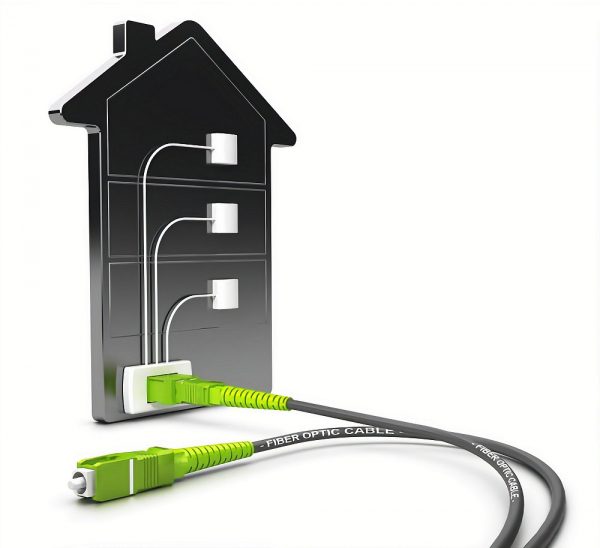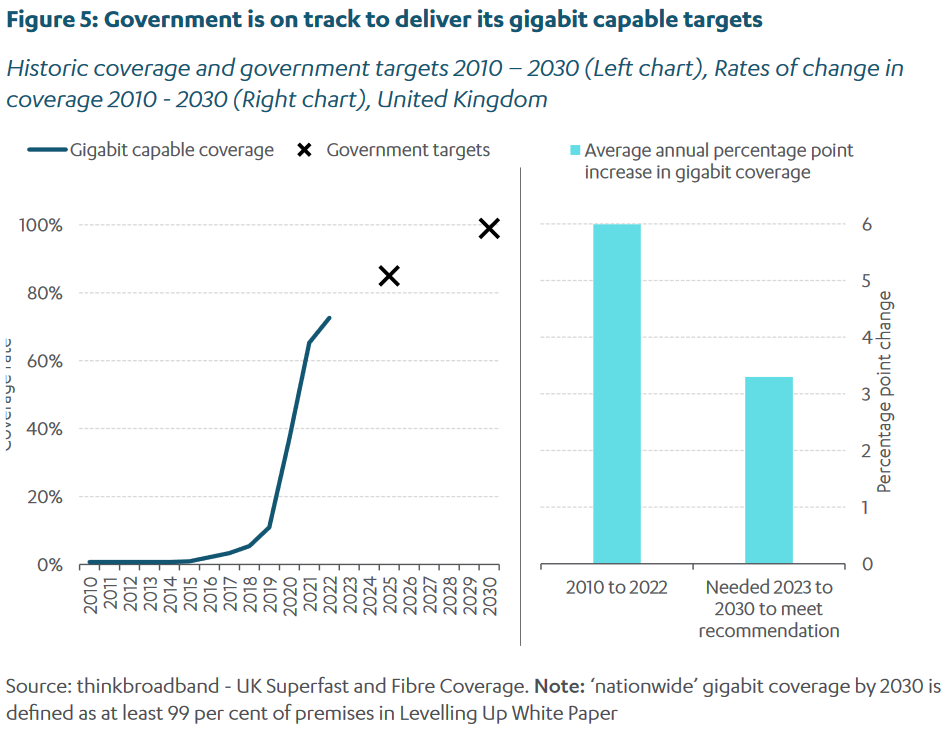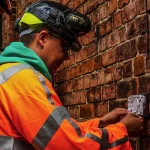Infrastructure Commission Praise UK Gigabit Broadband Progress

The National Infrastructure Commission (NIC) has published their annual infrastructure review, which highlights how the UK is making “rapid” progress in rolling out gigabit-capable broadband ISP networks and expects the Government to “achieve its target” for nationwide coverage by 2030. But 5G mobile still needs more direction.
At present, the UK has established two main digital connectivity projects. The first is their £5bn Project Gigabit programme, which aims to make gigabit-capable (1Gbps+) broadband ISP networks available to at least 85% of UK premises by the end of 2025 and then “nationwide” (realistically c.99%) by 2030 (Winter 2023 Progress Update). Commercial investment is largely expected to push this to c.80% of UK premises by the end of 2025, with public funding being used to help upgrade those in the final 20% of hardest to reach premises.
The second project is the £1bn Shared Rural Network (progress update), which aims to extend geographic 4G based mobile (mobile broadband) coverage to 95% of the UK by the end of 2025. The same infrastructure will also help 5G coverage too, even though it isn’t specifically part of the coverage target.
Advertisement
In the past, the NIC has tended to criticise the government’s slow pace of progress in implementing these schemes, particularly Project Gigabit. But the latest annual Infrastructure Progress Review 2023 adopts a very different tone and appears to praise it – noting that it now meets all of their five tests for planning, funding, change, delivery and long-term strategy (the only project to do so).

However, the NIC warns that the government still needs to “set out a clear vision” for 5G mobile networks, which should form part of the forthcoming Wireless Infrastructure Strategy (WIS).
NIC Statement on Gigabit Broadband and Mobile
Government has made a genuine commitment to change digital connectivity across the country. Delivery of gigabit capable broadband networks is progressing rapidly and, in 2022, gigabit capable coverage was extended to over 70 per cent of premises. This reflects significant increased investment from operators in recent years. If operators deliver on their published plans, and government maintains the £5 billion subsidy programme for underserved areas, government will achieve its target to deliver nationwide coverage by 2030.
On mobile, 4G coverage from at least one operator now extends to around 92 per cent of the UK landmass, and the Shared Rural Network agreement should increase this to 95 per cent by the end of 2025, with further coverage improvements in the harder to reach areas continuing to be delivered until the start of 2027.
Mobile network operators are also extending their 5G network across the UK, and coverage outside of premises from at least one operator now stands at around 70 per cent. There has also been some improvement on coverage on the road network. However, challenges remain on upgrading mobile coverage on the rail network and securing investment for deploying new 5G networks.
Government must now set out a clear vision for 5G mobile networks in the upcoming Wireless Infrastructure Strategy. The long term commercial and strategic value of 5G will be determined by whether it becomes more than just a faster version of 4G, and whether it provides solutions to pressing problems.
On the one hand, it’s good to see some praise for Project Gigabit, but on the other hand, it’s important to reflect that some parts of the UK have yet to even enter the procurement pipeline and that includes Scotland, Wales and Northern Ireland. The project, after several years, is only now just starting to award its first contracts and so it will take time before this really starts to have a noticeable impact.
Advertisement
Otherwise, the vast majority of gigabit-capable coverage made to-date has come from commercial operators, particularly Virgin Media’s upgrade (DOCSIS 3.1) of their old Hybrid Fibre Coax (HFC) network that quickly reached 14.3 million premises – this has somewhat inflated the progress figures between 2019 and early 2022.
The progress being made beyond that will largely come from full fibre (FTTP) deployments by commercial operators, mostly still in urban areas. Openreach expect to reach 25 million premises by December 2026, while Virgin Media (inc. Nexfibre) may reach a combined 23 million by 2028 (21m by 2026) and then there’s the mass of alternative networks. But there are question marks over how close AltNets will get to their ambitious targets, given the current market strains.
As for 5G mobile, the government has always been a bit weak on this area. The Conservative’s 2017 manifesto actually promised “to have the majority of the population covered by a 5G signal by 2027,” which was somewhat bizarrely downgraded to 2030 in the Levelling Up Plan (here). We say bizarrely because a majority is anything over 50%, which is an easy goal that operators like EE and Three UK have already met. Hopefully the future wireless strategy might finally show a bit more ambition, but don’t bank on it.
Mark is a professional technology writer, IT consultant and computer engineer from Dorset (England), he also founded ISPreview in 1999 and enjoys analysing the latest telecoms and broadband developments. Find me on X (Twitter), Mastodon, Facebook, BlueSky, Threads.net and Linkedin.
« BT Group UK Reportedly Hunting for New CEO to Replace Jansen
CityFibre Complete Binley Woods FTTP Broadband Rollout »






















































According to INCA, altnets have secured £17bn of funding to pass 10m premises by 2025. Throwing that against the 25m for OR and 21m for VM, and noting there’s only 27m homes in the UK, it would seem that the biggest achievement of policy by the middle of the decade will be massive overbuild and duplication of infrastructure in urban and suburban areas whilst still making snail like progress on the hard to serve. I’ve already got a choice of two gigabit options, and I’m getting altnet marketing promising that they’re building a third network here in the next few months. Meanwhile (as one of thousands of examples) our friends in Puddington can’t get a mere £60k to kick start FTTP in their village.
I’m not suggesting OR or VM should enjoy defacto monopolies of high speed, but good regulation is about steering the outcomes, and with so much money going into commercially questionable duplication, that steering appears lamentably absent.
5G rollout has rolled out fast, but the quality wildly varies based on provider. For example with O2 in London Bridge, despite touting full signal, data does not work at all.
Think the 4G coverage in harder to reach areas will be for the Government to burden, especially with the 3G switch off
End of 2025 is a key date as the copper switch off will remove many of the services that more rural locations rely on. Alternatives needed will be a mix of 4G, FTTP and satellite.
Government funding is critical to reach more dispersed premises where standalone build costs can be in the £100k’s just for FTTP. Given the time it takes for physical builds, especially with dig permits and wayleaves needed and adding extra delay – it’s crucial that Project Gigabit timescales and subsequent processes can be stepped up to give adequate build time.
Fully agree on the overbuild comments. A choice is good for pricing being competitive but thus far it has largely been at the expense of wider geographic coverage.
Working for GoFibre the Scottish AltNet serving Scotland and the North of England we have a deliberate strategy to build in underserved areas that have been missed out and the funding we have from the Gresham House British Sustainability Fund recognises this. We can connect wholesale to other build areas so our sole focus on build is to reach the premises in towns and villages that need it most.